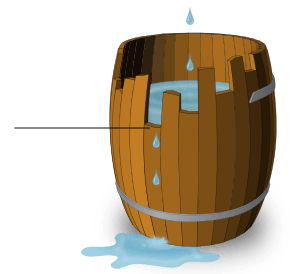Law of the Minimum facts for kids
The Law of the Minimum, also known as Liebig's Law of the Minimum, is an important idea about how living things grow. It says that the growth of a plant, or even a group of animals, is limited by the resource that is the hardest to find or the least available. It's not about the total amount of all resources, but about the one that runs out first.
This law helps us understand why plants might not grow well even if they have plenty of most things they need, like sunlight or water. If just one important nutrient is missing or very scarce, that's what stops their growth.
Liebig's Barrel: An Easy Way to Understand
To make the Law of the Minimum easier to understand, scientists often use the idea of "Liebig's barrel." Imagine a wooden barrel made of many staves (the vertical planks that form the sides). If all the staves are different lengths, the barrel can only hold water up to the height of its shortest stave. No matter how tall the other staves are, the water will spill out once it reaches the shortest one.
In the same way, a plant's growth is like the water in the barrel. The different staves represent the different things a plant needs to grow, like water, sunlight, nitrogen, phosphorus, or potassium. If one of these "staves" (resources) is in very short supply, it becomes the "shortest stave" and limits how much the plant can grow. Even if all the other resources are plentiful, the plant can't grow any more than what the scarcest resource allows.
For example, if a plant has plenty of water and sunlight, but not enough nitrogen in the soil, its growth will be limited by the lack of nitrogen. Adding more water or sunlight won't help until more nitrogen is available.
Why This Law Matters
Understanding the Law of the Minimum is very useful in many areas:
- Farming: Farmers use this law to figure out which nutrients are missing from their soil. By adding just the right amount of the missing nutrient, they can help their crops grow much better.
- Ecology: Scientists who study ecosystems use this law to understand what limits the growth of populations of plants and animals in nature.
- Gardening: If your garden plants aren't thriving, this law suggests you should check for the one thing they might be missing the most, rather than just adding more of everything.
This law teaches us that sometimes, fixing one small problem can make a huge difference!
See also

- In Spanish: Ley del Mínimo de Liebig para niños


